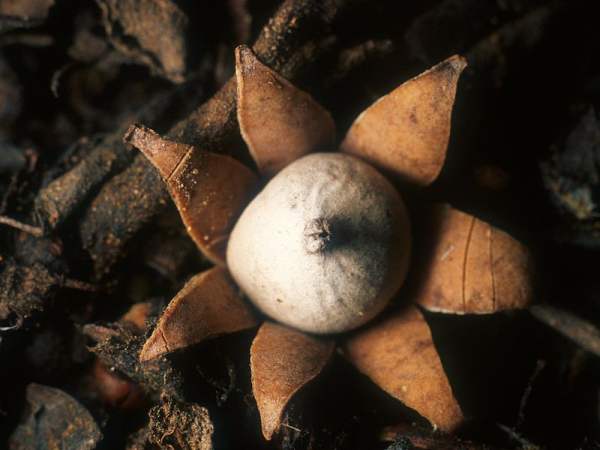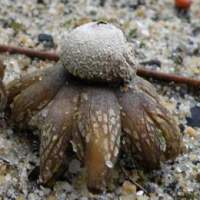Geastrum floriforme Vitadd. - Daisy Earthstar
Phylum: Basidiomycota - Class: Agaricomycetes - Order: Geastrales - Family: Geastraceae
Distribution - Taxonomic History - Etymology - Identification - Culinary Notes - Reference Sources

Picture: Nathan Wilson/Wikipedia
Earthstars all look much the same, until you examine them closely. No conclusing can be drawn from the number of rays, as they are very variable. The shape and colouring of the opening at the top of the spore sac plus the attachment of the spore sac to the outer layer that forms the rays are key features. The gleba of the Daisy Earthstar is a paler brown than most other species.
At its best, this is a very attractive little fungus, and often it occurs in photogenic groups.
Distribution
This is a fairly common species in central and southern mainland Europe and it occurs also in some parts of North America, but in Britain and Ireland the Daisy Earthstar is a very rare find, mainly restricted to southern coastal areas. Geastrum floriforme is one of several earthstars - all fairly uncommon to rare finds in Britain and Ireland - that have long-lasting fruitbodies such that you can find them at any time of year.
Taxonomic history
The Daisy Earthstar was described scientifically in 1842 by Italian mycologist Carlo Vittadini (1800 - 1865), who gave it the binomial scientific name Geastrum floriforme by which it is still generally known today.
Synonyms of Geastrum floriforme include Geastrum delicatus Morgan, Geastrum simulans Lloyd, Geastrum spegazzinianum De Toni, Geaster floriformis Vittad., and Geastrum sibiricum Pilát.
Etymology
Geastrum, the generic name, comes from Geo- meaning earth, and -astrum meaning a star. Earthstar it is, then. The specific epithet floriforme means shaped like a flower (and to be more precise a daisy flower!).
Identification guide
 |
FruitbodyA flattened sphere holds the powdery gleba with which the spores are distributed. A raised hole on the top of the 'bulb' releases spores when the wind blows across it. The bulb is mounted on a star-shaped base that looks rather like the petals of a daisy, with 5 to 10 pointed rays that sometimes curl under the fruitbody slightly. |
Spore sacThe spore sac (bulb) is typically 1 to 2cm across and roughly spherical but squashed somewhat vertically - an oblate spheroid, therefore. The spores emerge via a small raised hole. There is no noticeable stem between the spore sac and the platform of rays upon which it stands. |
|
Other features |
When fully expanded the rays of the earthstar more than double its diameter. The number of star rays is very variable - the specimen illustrated here has seven rays but some have more and others fewer. |
SporesSpherical, 5-6.5µm in diameter; covered in fine warts. Spore massDark brown. |
|
Odour/taste |
Not noticeable. |
Habitat |
Mainly found in sandy open areas under either conifers or broadleaf trees. The fruitbodies can occur either solitarily or in scattered groups. |
Season |
Fruiting after rain in the autumn; visible all year round. |
Similar species |
Several other Geastrum species are of the same general form, and confident identification requires microscopic study (and a lot of expertise). |
Culinary Notes
Earthstars are inedible and have no culinary value, but when dried they can make attractive table decorations as long as they do not get mistaken for pepper shakers!.
Reference Sources
Fascinated by Fungi, 2nd Edition, Pat O'Reilly 2016, reprinted by Coch-y-bonddu Books in 2022.
Ellis JB, Ellis MB. (1990). Fungi without Gills (Hymenomycetes and Gasteromycetes): an Identification Handbook. London: Chapman and Hall. ISBN 0-412-36970-2.
Pegler, D.N., Laessoe, T. & Spooner, B.M (1995). British Puffballs, Earthstars and Stinkhorns. Royal Botanic Gardens, Kew.
Dictionary of the Fungi; Paul M. Kirk, Paul F. Cannon, David W. Minter and J. A. Stalpers; CABI, 2008
Taxonomic history and synonym information on these pages is drawn from many sources but in particular from the British Mycological Society's GB Checklist of Fungi.
Fascinated by Fungi. Back by popular demand, Pat O'Reilly's best-selling 450-page hardback book is available now. The latest second edition was republished with a sparkling new cover design in September 2022 by Coch-y-Bonddu Books. Full details and copies are available from the publisher's online bookshop...

